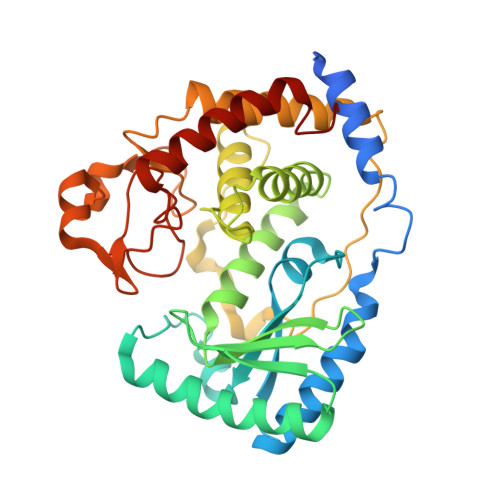Dual role of the RNA substrate in selectivity and catalysis by terminal uridylyl transferases.
Stagno, J., Aphasizheva, I., Aphasizhev, R., Luecke, H.(2007) Proc Natl Acad Sci U S A 104: 14634-14639
- PubMed: 17785418
- DOI: https://doi.org/10.1073/pnas.0704259104
- Primary Citation of Related Structures:
2Q0C, 2Q0D, 2Q0E, 2Q0F, 2Q0G - PubMed Abstract:
Terminal RNA uridylyltransferases (TUTases) catalyze template-independent UMP addition to the 3' hydroxyl of RNA. TUTases belong to the DNA polymerase beta superfamily of nucleotidyltransferases that share a conserved catalytic domain bearing three metal-binding carboxylate residues. We have previously determined crystal structures of the UTP-bound and apo forms of the minimal trypanosomal TUTase, TbTUT4, which is composed solely of the N-terminal catalytic and C-terminal base-recognition domains. Here we report crystal structures of TbTUT4 with bound CTP, GTP, and ATP, demonstrating nearly perfect superposition of the triphosphate moieties with that of the UTP substrate. Consequently, at physiological nucleoside 5'-triphosphate concentrations, the protein-uracil base interactions alone are not sufficient to confer UTP selectivity. To resolve this ambiguity, we determined the crystal structure of a prereaction ternary complex composed of UTP, TbTUT4, and UMP, which mimics an RNA substrate, and the postreaction complex of TbTUT4 with UpU dinucleotide. The UMP pyrimidine ring stacks against the uracil base of the bound UTP, which on its other face also stacks with an essential tyrosine. In contrast, the different orientation of the purine bases observed in cocrystals with ATP and GTP prevents this triple stacking, precluding productive binding of the RNA. The 3' hydroxyl of the bound UMP is poised for in-line nucleophilic attack while contributing to the formation of a binding site for a second catalytic metal ion. We propose a dual role for RNA substrates in TUTase-catalyzed reactions: contribution to selective incorporation of the cognate nucleoside and shaping of the catalytic metal binding site.
Organizational Affiliation:
Department of Molecular Biology and Biochemistry, University of California, Irvine, CA 92697, USA.
















